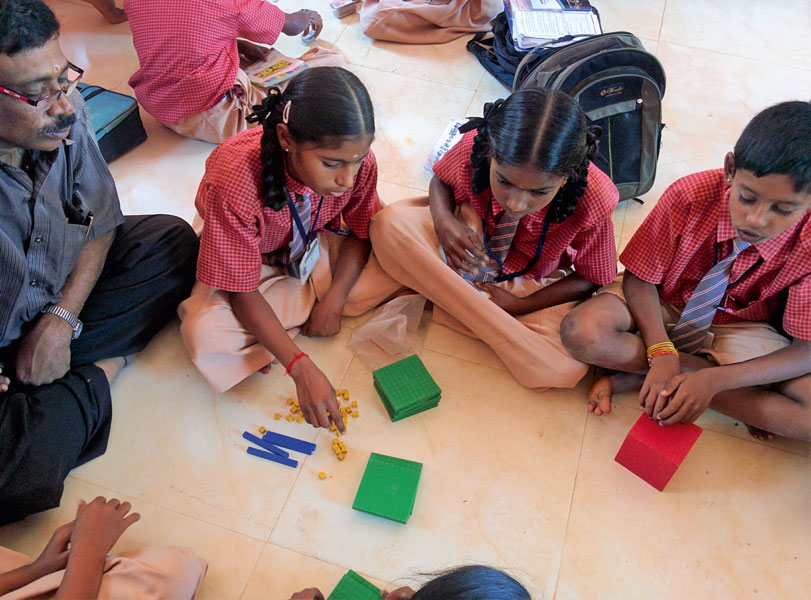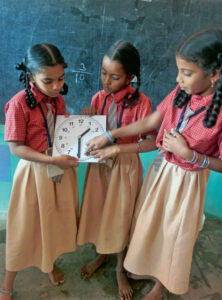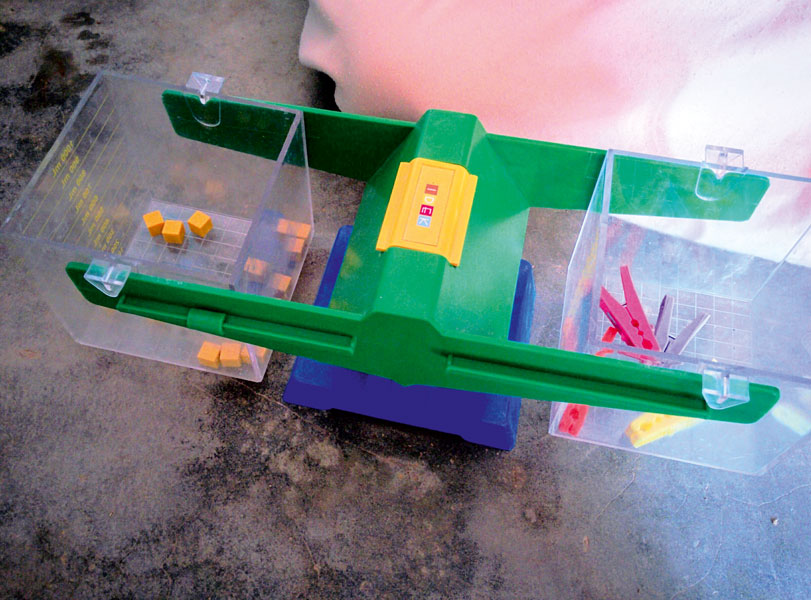The Akshara Foundation, a Bengaluru- based NGO, has been working in the field of children’s education for over 15 years. Over the years, they have developed high-quality learning and teaching aids for Math and English that are used in thousands of government schools in Karnataka.

I visited the Government Higher Primary School in Tavarekere, Hoskote taluk, just outside Bengaluru, to witness the Akshara Math programme at work. My focus was on Classes 4 and 5. Children demonstrated their familiarity with subtraction and addition with use of the abacus. They were not only familiar with fraction strips, geo board, clock, play money notes, measuring tape and many other such learning materials, but were also eager to participate in the class.
These materials are colourful and are like toys. Children like to feel and touch and actually see for themselves how they can get the right answer.
Their teachers Subramani and Rashmi extolled the virtues of the Akshara Math kits. “They have made our jobs much easier,” said Rashmi, who teaches Classes 6 and 7. “Earlier we would struggle to explain simple concepts to many of them, but now they are enthusiastic. These material are colourful and are like toys. Children like to feel and touch and actually see for themselves how they can get the right answer….They don’t have to simply imagine.”
Subramani, the Class 5 teacher, concurred: “Slow learners have picked up. It is showing in their report cards and parents are happy. Also, because they work in groups, a lot of peer learning happens. They observe how the others use the material and learn much faster.”
I sought a demonstration. Little Nithyashree from Class 4 was promptly summoned and she showed me how she does addition with carrying over. “Not too long ago she used to struggle with the concept of numbers,” her teacher said, warmly applauding her effort. “Do you like Math?” I asked the child and she nodded seriously. “Why do you like this abacus?” I persisted. She thought about it for a bit before she declared. “It’s nice.”

The Akshara Foundation is in the process of expanding its reach to cover more districts in Karnataka.Excerpts from the interview with Ashok Kamath, Managing Trustee and Chairman of the Foundation:
In the time since its inception, what have been Akshara’s greatest challenges?
The State or the community or (ideally) both should take ownership of the programme during the later part of the implementation phase. Ensuring that these three requirements happen has been our greatest challenge.
Scaling up has been a challenge for Akshara. Because of the increased number of schools and children, the monitoring process had to be streamlined. For example, we felt the need for a process for monitoring the roll-out of Ganitha Kalika Andolana (GKA) — that aims to revolutionise the teaching of basic Math — on a continuous basis to help us identify weak areas. In 2015–16, we tried an IVRS-based solution and found deficiencies: call cost was too expensive on a per call basis; calls would drop in the middle of the response, making calls invalid. And there were too many questions in the application. The State Government too was not comfortable with IVRS.
So based on both the State and our needs, we have now come up with a new and improved SMS-based process with fewer questions. To ensure sustainability of our programmes, we have to make sure that all our stakeholders like parents, community, teachers etc are involved concurrently in the process of education.
Finally, the programmes should be simple enough for replication in any region, right from the curriculum stage to the training modules.
What kind of teacher training programmes does Akshara conduct?
Teachers learn to use the TLM effectively through a face-to-face training programme. Training is done using a cascade method that ensures sustainability. In programmes that have gone to scale such as GKA, the training is backed by video modules which are available to teachers via our website and through DVDs.
How do you keep track of the various schools and learning centres that have adopted the Akshara model?
Technology-based assessment—learning outcomes are evaluated through the use of an in-house Android app. By equipping our field team with the app installed on electronic tablets, we are able to test children every month in the whole district. Children are randomly selected in a class and given the tab to individually solve a set of questions.

We use an SMS-based process to monitor efficiency, and monitor whether the programme is happening in the schools as scheduled, the teachers have been adequately trained, and so on. This process helps provide onsite support for the teachers and helps us identify their weak spots and build on their strengths.
The research and evaluation team checks the effectiveness of programmes through careful scrutiny. The Karnataka Learning Partnership is another major framework through which the efficacy of different variables in Akshara’s programmes is being tracked.
What is the goal of the Karnataka Learning Partnership (KLP)?
The Karnataka Learning Partnership was set up by Akshara in 2006 to improve the quality of education. It seeks to leverage the work of each education-based or linked organisation in ways that drive collective, rather than individual and isolated impact. KLP brings together the efforts of its partners, who work in education, health, nutrition and allied areas, and provides comprehensive data on a single platform.
How do you source books for the classroom libraries?
Books of all kinds and genres in languages like English, Kannada, Tamil, Telugu, and Urdu are sourced from reputed publishers of children’s literature.
Teaching and learning methodologies keep evolving. What has changed in the last 15 years?
Our target constituency is the bottom of the pyramid — children studying in government schools in rural communities. One of the key things we have done is use Activity Based Learning (ABL) as opposed to rote learning method. For example, our innovative GKA makes mathematics a fun subject rather than the rote learning, boring subject that it can be. There is a math kit which is used to teach children which moves from concrete to representational to abstract (CRA).





